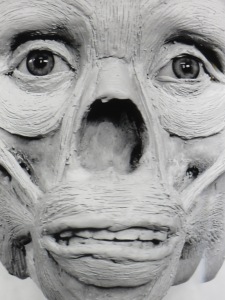In the valley of the Vézère river (Dordogne, France) they have found a lot of remains of early modern humans, Crô-Magnons. This name has become a common name for describing the first Homo sapiens sapiens. The earliest founds date from 1868 under the abri Crô-Magnon. An abri is a shelter, a partial overhanging, a Crô is the Occitan word for hole or cavity, while Magnon is told to be the name of the owner of this place. This first finding is on view now in Musée de l’Homme in Paris. We are in the age of the Late Paleolithic. The oldest found bones up till now are dated 43.000 ybp.
In fact you can say here is our craddle. But it must be emphasized that before, during and after these people lived her, a lot of fusions with other groups of humans have been taken place, including interbreeding with Neanderthals who, although for a long time thought, were not at all inferior to these “new” group. On the contrary; many characteristics, habits and skills have been acquired by the Crô-Magnon from these Neanderthals. So many remains hawve been found in this area and a lot of places are open to public. To see all the finds, visit the wonderful National Museum of Prehistory in Les Eyzies.
Many founds, yes. Not only skeletal-fragments, also tools, and works of art. These can be very beautiful. Most famous are the unbelievable wall paintings of Lascaux cave (a full copy is now,2015, under construction) and many encarvings and sculptures. Women statues have been found here and all over Europe.
 Venus of Willendorf (22.000 à 24.000 ybp). On view in the Museum of Natural History in Vienna, Austria.
Venus of Willendorf (22.000 à 24.000 ybp). On view in the Museum of Natural History in Vienna, Austria.
Quite near the place where the first Crô-Magnon remains were found, in the village of Les-Eyzies-de-Tayac, the shelter of Pataud is situated. Here they found the remains (17.000 ybp) of the ‘Woman of Pataud’. These bones have been used to make a real good-looking reconstruction of her, by the artist Elisabeth Daynes. Although some characteristics are just fantasy, like dreadlocks and skin markings, it is said that she looked quite like her reconstruction. She has a very lively look; a great work of art too. Her skin color could be the same as it is on the photo. But the earliest Crô-Magnons had a darker skin, dark hair and blue eyes, according to scientist who investigated DNA.
She was in 2014 on show in the Pôle International de la Préhistoire in Les Eyzies-de-Tayac-Sireul in France. In autumn that year she moved to Bordeaux. Where she hangs out now, I don’t now at the moment. Probably she went back to Les Eyzies, where she died. Ask for it at the ‘Pôle’ or the National Museum of Prehistory where you can see beautiful other reconstructions like Neanderthal humans and Lucy, in Les Eyzies too. Admire her!
P.S. I found out that she is now on show in the Pataud Museum in Les Eyzies!

